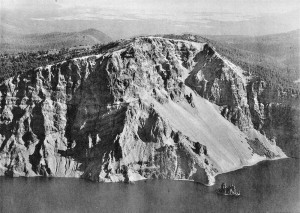True explosion breccias are not lacking on Dutton Cliff, but they are readily distinguishable by reason of their stratification and depositional relations to the lavas beneath. The most conspicuous of these pyroclastic bands is one composed of pale sage-green tuff breccia, which reaches a thickness of 50 feet in places and carries angular blocks of andesite up to 3 feet across. It outcrops a short distance below Sun Notch and continues thence eastward toward Kerr Notch, as shown in plate 6.
|
Plate 6. Dutton Cliff and Phantom Ship. The triangular cliff in the center of the picture is the filling of a vent, possibly the oldest on Mount Mazama. From this, the Phantom Cone was built, of which Phantom Ship is part. The lakeward dips of the lavas and breccias of this cone are clearly shown. After extinction, the Phantom Cone was eroded and then buried by flows from the main vents of Mount Mazama. Note unconformity on the east (left) side between the Phantom and Mazama lavas. A second unconformity, among the Mazama flows, appears higher up the cliff. Thin glacial deposits occur at this horizon, and water seeps issue from them. (Photograph by U. S. Army Air Corps.) |
Farther down Dutton Cliff, and on Phantom Ship, pyroclastic deposits are more abundant. These are products of the Phantom cone and have been discussed already (page 30).
Coarse, red agglomerates and breccias occur as irregular lenses between the lavas above Danger Bay, but between Sentinel Point and Pumice Point pyroclastic deposits are both rare and thin. In the lower part of Pumice Point, however, there occurs a layer of tuff breccia 150 feet thick. Thin bands of similar ejecta may also be found between the lavas on the walls of Steel Bay and beneath Llao Rock.
From what has been said it may be concluded that although explosive activity continued at intervals throughout the growth of the main cone of Mount Mazama, it was far subordinate to effusive activity. Such explosions as there were must have been principally at a low temperature, the ejecta being blown out for the most part in a solid state as angular blocks in a matrix of ash. True scoria (cinders) and rounded bombs are conspicuously absent; in other words, none of the explosions seems to have been of the Strombolian type, in which the ejecta are blown out while still sufficiently viscous to have their forms modified by flight through the air.
The nature of the pyroclastic deposits provides evidence that the feeding magma chamber or explosion focus lay at shallow depth, for despite a careful search no fragments of the Western Cascade lavas or of the underlying rocks have ever been found among them. Indeed, fragments referable to the older Pliocene lavas beneath Mount Mazama are extremely rare, the ejecta being almost entirely composed of typical Mazama andesites. On other volcanoes in the southern Cascades there is a similar absence of explosion debris from the underlying basement. Presumably the tops d the magma chambers lay close to the surface; that of Mount Mazama may have been well above the level of the Miocene lavas and probably lay among the upper flows of the Pliocene High Cascade basalts. If this inference is justified, it helps to explain why the earlier explosions of Mount Mazama were not especially violent, for magma at shallow depth cannot hold enough gas in solution to cause explosions of great intensity.
***previous*** — ***next***


